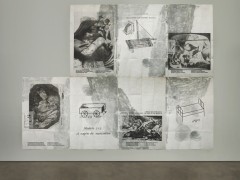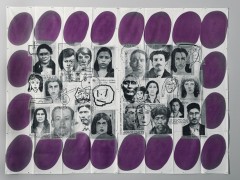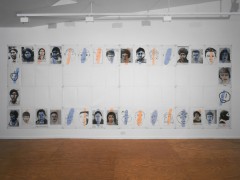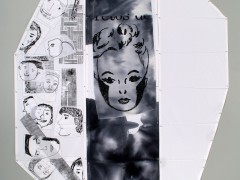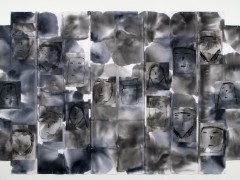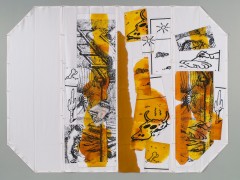Eugenio Dittborn – Your Letters. Pinturas Aeropostales 1986–2012
Museum Het Domein, Sittard
26.05 – 09.09 / 2013
The Chilean artist Eugenio Dittborn (b. 1943, Santiago) is internationally acclaimed with the Airmail Paintings that he has been making since 1983. Dittborn continues to send his folded paintings all over the world by airmail in large envelopes specially designed for this purpose. The invention of the Airmail Paintings was Dittborn’s solution to the challenges of working as an artist in Chile during the military dictatorship of Augusto Pinochet. By disguising his artworks as postal items, Dittborn got around bureaucracy and gained visibility in the international art circuit. With his Airmail Paintings, Dittborn was an early pioneer in reflecting on the globalization of the (art) world. His paintings are always on the go. The frequent journeys and connections the works make with different places constantly enrich the Airmail Paintings and allow us to re-evaluate them. The airmail envelopes that Dittborn designed are an integral component of the works and provide information about the backgrounds and travel routes of the paintings. ‘In a sense, the thing is not so much to read what is in the Airmail Paintings as to read what the paintings are incessantly doing: traveling,” argues the artist in his manifesto Roadrunner. “The Airmail Paintings arrive, and all eyes are drawn to where they hang outspread on the wall. Then they draw away as departure nears. An Airmail Painting is what is seen between two journeys.”
Dittborn characterizes his Airmail Paintings as “letters in transit” or “homeless paintings.” He describes his invention of the paintings with their often enormous formats as relatively accidental. Initially he made the paintings on large sheets of brown paper that he folded up to one-sixteenth of their original size. Twice he changed the support of the paintings: since 1986 Dittborn has used non-woven fabric, which he exchanged for cotton duck in 1994. The evocative force of Dittborn’s work often can be found in the ambivalent manner by which he combines visual motifs. He frequently makes use of found images: photos from Chilean newspapers over the past fifty years, sports magazines, criminology journals, anthropological and archaeological handbooks. In addition to using found material, the artist integrates drawings specially created for this purpose by the most diverse communities, ranging from children (including his daughter) to patients suffering from schizophrenia at the Santiago Psychiatric Hospital. The collaborative character of much of his work makes Dittborn a trailblazer in this area.
The exhibition at the Museum Het Domein will be Dittborn’s first solo museum exhibit in Europe in fourteen years and the first time the work will have been on display in the Netherlands since 1993, when Witte de With in Rotterdam devoted an early one-man show to him. The exhibition at Museum Het Domein kicks off with work that Dittborn created in 1993 at Rotterdam’s so-called ‘Platform Zero’ in collaboration with the heroin addicts who found refuge there. The exhibition will feature a sizeable selection of Dittborn’s monumental work from the last twenty years, which is as colorful as it is probing. Last year, Museum Het Domein enriched its collection of contemporary art with Dittborn’s iconic work The 23rd History of the Human Face (Aljo-Violet). Airmail Painting No. 128 from 1999.
Practical informations
From Tuesday through Sunday from 11 am till 5 pm.
Kapittelstraat 6
6131 ER Sittard
The Netherlands
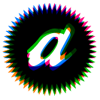

 Home
Home
